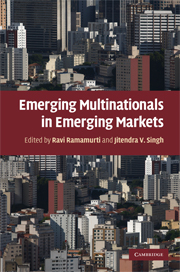Book contents
- Frontmatter
- Contents
- List of figures
- List of tables
- List of abbreviations
- List of contributors
- Acknowledgments
- Part I Introduction
- 1 Why study emerging-market multinationals?
- 2 Third World multinationals: A look back
- 3 Theoretical aspects of MNEs from emerging economies
- 4 Does firm ownership matter? POEs vs. FOEs in the developing world
- Part II Country Studies
- Part III Conclusions
- Index
- References
4 - Does firm ownership matter? POEs vs. FOEs in the developing world
from Part I - Introduction
Published online by Cambridge University Press: 03 July 2009
- Frontmatter
- Contents
- List of figures
- List of tables
- List of abbreviations
- List of contributors
- Acknowledgments
- Part I Introduction
- 1 Why study emerging-market multinationals?
- 2 Third World multinationals: A look back
- 3 Theoretical aspects of MNEs from emerging economies
- 4 Does firm ownership matter? POEs vs. FOEs in the developing world
- Part II Country Studies
- Part III Conclusions
- Index
- References
Summary
The nationality of a firm's owner doesn't matter for economic development in perfectly competitive markets. A foreign-owned enterprise (FOE) from a developed country or a privately owned enterprise (POE) from a developing country are equally capable if both have access to the same inputs and marketing opportunities (ignoring SOEs and tiny enterprises). Where the theory of free competition reigns, developing countries should open their arms to investments from all types of firms in order to maximize jobs, as many Asian countries did using export processing zones. Ownership, measured by votes of shareholders or boards of directors, is immaterial to performance.
Matters change drastically, though, when competition depends on monopolistic assets and market theory no longer rigorously holds, as in “mid-tech” industries such as shipbuilding, steel, and heavy machinery, and “mature” high-tech industries, such as calculators, computers, and cell phones, after millions of units from advanced countries have already been sold but demand is still booming. Knowledge, brand names, political clout, and other sources of market power vary by firm and influence market outcomes. Then, ownership matters.
Because FOEs have controlled more competitive assets than POEs since the First Industrial Revolution, they have gained the upper hand and the respect of the elite business schools, that tend to view them as the best policy choice for backward countries to follow. FOEs are highly productive, the argument runs, and somehow transfer knowledge (measured by “spillovers”) to local enterprise, so invite them into your midst.
- Type
- Chapter
- Information
- Emerging Multinationals in Emerging Markets , pp. 64 - 78Publisher: Cambridge University PressPrint publication year: 2009



